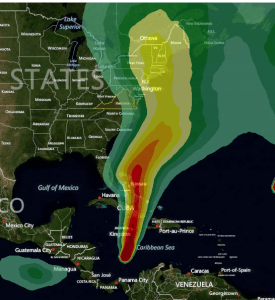


A division of the company that brings viewers The Weather Channel will formally launch a new 15-day hurricane forecast model in May, a considerable advance over the predictive norm, which only forecasts three to five days out.
Dubbed Tropical PHD (Predictive Hurricane Decision-Support), the model comes out of WSI, the professional division of The Weather Co., which also owns The Weather Channel. WSI is considered The Weather Channel’s innovation engine and also provides products for the energy, aviation, insurance and media markets as well as some federal agencies.
WSI’s Tropical PHD rolled out with a soft launch just a few weeks ago and is due for a formal release on May 15, targeted for the upcoming hurricane season. Andy Rice, WSI’s general manager of enterprise products, said the new model is a big advance over traditional hurricane models currently in use.
“The traditional hurricane forecasts that are out there generally only cover three to five days in the future,” Rice told Carrier Management via email. “While these forecasts are very accurate, people/companies who have an invested interest are searching for information weeks out.”
WSI’s new hurricane model technique takes more than 50 individual forecast models and corrects for historical biases each model has under certain environmental conditions, Ray Hawthorne, meteorologist and insurance product manager for WSI, explained to Carrier Management in a statement.
Rice said that the algorithms at play for the new WSI hurricane model “refer back several decades to data mine and analyze how well each of the tracks perform when predicting the ultimate path of the storm. We look at trends of when certain models tend to cluster together and note whether that increases the likelihood of the storm taking that track.”
Hawthorne explained that the model already showed some promise with Hurricane Sandy, and it “performed better” on Tropical Storm Karen “and the hurricanes that hit Mexico than most of its other counterparts.”
“The model forecasted about a 50 percent probability of landfall [of Hurricane Sandy] in the New York/New Jersey area with a week’s notice,” Hawthorne said. “If you think about it, that probability is extraordinarily high considering that the probability of a storm with tropical origins making landfall in that area in late October is quite unusual.”
A wider hurricane forecasting model will be of interest to a wide range of industries, Rice said.
“Many companies do care about medium-term (two to four weeks), low-probability, high-impact” events,” he said. “This information may enable them to make different decisions when it comes to managing their business or hedging risk. Having the ability to convey that there is a 5 percent risk of a hurricane 11 days from now will change business decisions.”
WSI, The Weather Channel and Weather Underground are part of The Weather Co., which is owned by NBC Universal, plus private equity firms Bain Capital and The Blackstone Group.